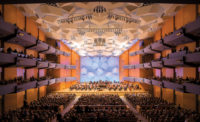Well before Herzog & de Meuron expanded the Walker Art Center and Jean Nouvel dreamed up a new Guthrie Theater, Minneapolis had been home to contemporary architecture.

When Hardy Holzman Pfeiffer completed Orchestra Hall on the city’s Nicollet Mall in 1974, for example, the daringly stripped-down design rejected the privilege associated with traditional symphony spaces. In 2013 the building will portray a new interpretation of Modernism when an expansion overseen by Toronto-based Kuwabara Payne McKenna Blumberg (KPMB) opens to the public. The Minnesota Orchestral Association announced its selection of KPMB in June, culminating a seven-month-long international search process.
Orchestra Hall is renowned for its 2,450-seat auditorium—a freestanding brick interior structure that features sound-reflecting cubes suspended from its ceiling and overall acoustics by Cyril Harris. “Unlike the performance hall, which has stood the test of time admirably, the public and support spaces are chronically in need of an overhaul,” says KPMB partner-in-charge Marianne McKenna. Currently the Orchestra Hall lobby can hold only 800 people, for example.
In addition to refreshing the concert hall, KPMB will rewrap it, emphasizing bolstered lobby space. The expansion will connect to, but not encroach upon, Peavey Plaza, an adjacent sunken public space that was completed by M. Paul Friedberg in 1975. “The opportunity is to reconnect Orchestra Hall’s social spaces to Peavey Plaza, and to the dynamic of the city,” explains McKenna.
Bruce Kuwabara says the firm’s recently completed Toronto works, such as the National Ballet School (2005), Gardiner Museum (2006), and Royal Conservatory of Music (2009), will inform the upcoming redesign. Currently KPMB is assessing the building’s existing infrastructure, which includes the massive air-intake and exhaust vents that punctuate the glass-brick-and-steel exterior. McKenna says these signature elements may be incorporated in the redesign, or shifted.






